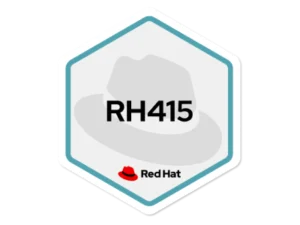Red Hat Services Management and Automation – RH358
IT professionals who have some experience managing Linux® systems and would like to learn more about how to deploy and manage the network services that come with Red Hat® Enterprise Linux—which are especially crucial in today’s IT data center—should take the Red Hat Services Management and Automation (RH358) course. Before using Red Hat Ansible® Engine to automate your work in a scalable, repeatable way, you will learn how to manually install, configure, and manage the most basic settings of these services.
Overview
The Red Hat Services Management and Automation course, sometimes referred to as EX358 or RH358, offers a thorough grasp of the fundamental network services and how to manage them in a Linux system. In order to maintain a strong IT infrastructure, this course aims to give students the skills they need to effectively manage and automate a variety of network services.Through a sequence of courses, learners will explore subjects like DNS and DHCP server configuration, link aggregation for enhanced redundancy, and network service management. Using MariaDB to set up SQL databases, Apache HTTPD or Nginx to manage web servers, and Varnish and HAProxy to optimize web traffic are all covered in the course.
What you will Learn in this Red Hat Services Management and Automation – RH358 Course?
- Master key tools and techniques for managing network services to ensure reliable and efficient network operations.
- Configure link aggregation to enhance network connection redundancy and throughput using Linux network teaming.
- Manage DNS services, including troubleshooting, configuring caching nameservers, and setting up authoritative DNS servers.
- Implement and configure DHCP, DHCPv6, and SLAAC for efficient IPv4 and IPv6 address assignment.
- Set up network printers using IPP Everywhere and manage print queues to support organizational printing needs.
- Configure email transmission using system tools and Postfix to send emails through an outbound mail relay.
- Understand the fundamental operations of SQL databases and set up a basic MariaDB database service with the capability to perform simple SQL queries.
- Configure Apache HTTPD or Nginx web servers, set up virtual hosts, and secure connections using TLS-based encryption.
- Optimize web server performance by caching static content with Varnish and managing traffic with HAProxy for TLS termination and load balancing.
- Provide and manage file-based network storage using NFS and SMB protocols, and configure iSCSI initiators to access block-based storage.
Who should take up this Red Hat Services Management and Automation – RH358 Course?
- System Administrators
- Network Administrators
- DevOps Engineers
- IT Infrastructure Managers
- Database Administrators with a focus on MariaDB/MySQL
- Technical Support Specialists
- IT Professionals working with Linux-based environments
- Cloud Administrators
- Security Engineers responsible for network services
- Professionals preparing for Red Hat certification exams
- Web Server Administrators
- Storage and Database Engineers
Our Package
Discuss and review key tools and skills needed to manage network services.
Improve the redundancy or throughput of network connections of servers by configuring Linux network teaming between multiple network interfaces.
Explain the operation of DNS service, troubleshoot DNS issues, and configure servers to act as a DNS caching nameserver or as an authoritative name server
Explain and configure services used for IPv4 and IPv6 address assignment including DHCP, DHCPv6, and SLAAC.
Configure systems to print to a network printer that supports IPP Everywhere, as well as manage existing printer queues.
Discuss how mail servers operate, then configure a server to use system tools and Postfix to send email messages through an outbound mail relay.
Discuss the basic operation of SQL-based relational databases, perform basic SQL queries for troubleshooting, and be able to set up a simple MariaDB database service.
Provide web content from Apache HTTPD or Nginx web servers, then configure them with virtual hosts and TLS-based encryption.
Improve performance of your web servers by using Varnish to cache static content being served and HAProxy to terminate TLS connections and balance load between servers.
Deliver simple file-based network shares to clients using the NFS and SMB protocols
Configure iSCSI initiators on your servers to access block-based storage devices provided by network storage arrays or Ceph storage clusters.
Upcoming Batch
April 20th (Weekends)
FRI & SAT (4 Weeks)
08:30 PM to 01:00 AM (CDT)
April 18th (Weekdays)
MON – FRI (18 Days)
10:00 AM to 12:00 PM (CDT)
Red Hat Services Management and Automation - RH358 FAQs
RH358 teaches advanced automation of system administration tasks using Ansible and Shell scripting, focusing on managing services and automation, improving learners’ skills to streamline system management in enterprise environments.
Completing RH358 may lead to roles like DevOps Engineer, Systems Administrator, or IT Automation Specialist, in industries like tech, finance, and healthcare, offering paths to senior technical positions and management.
- Basic understanding of networking concepts, including TCP/IP, Internet Layer protocols, and network services (DNS, DHCP, etc.).
- Familiarity with Linux operating system concepts, such as the command line interface (CLI), file system structure, and system configuration.
- Experience with managing Linux systems, including installing and configuring software packages, and system maintenance.
- Knowledge of Linux networking commands and tools (e.g.,
ip,nmcli,netstat,ss,ping, etc.). - Fundamental skills in editing text files on Linux using editors such as
viornano. - Basic understanding of security concepts, including firewalls, SSL/TLS, and access permissions.
The course RH358 – Red Hat Services Management and Automation is linked to EX358.
The duration of the course 40 hours.
A laptop, decent internet speed, a Headset with microphone is required.








Reviews
There are no reviews yet.